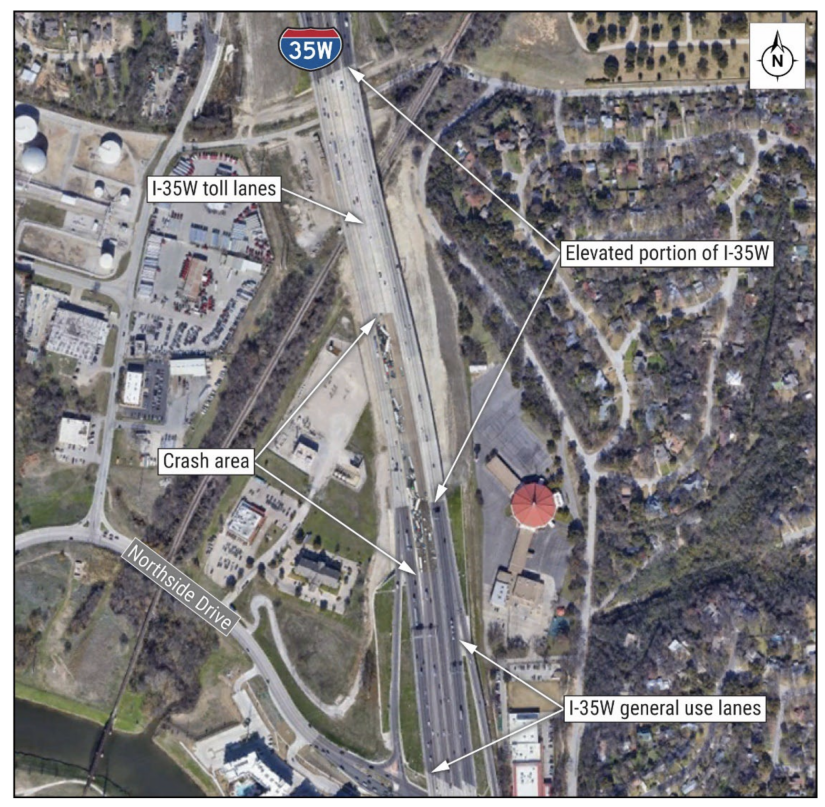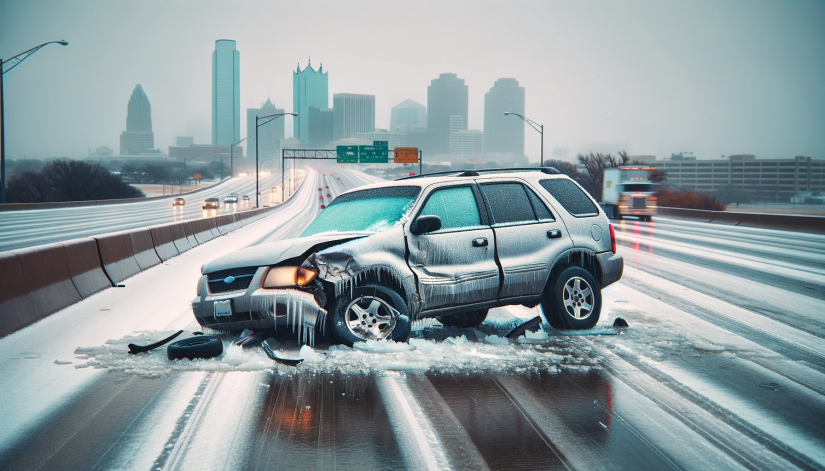Texas Black Ice Car Accident Claims: A Complete Guide
January 16, 2024

On February 11, 2021, a tragic incident unfolded on I-35W near Fort Worth, Texas, when a 133-car pileup resulted in six fatalities and over 60 injuries. This catastrophic event started early in the morning, amid 36 consecutive hours of sub-freezing temperatures that had besieged the area.
The National Transportation Safety Board reported that the crash spanned approximately 1,100 feet, involving both commercial and passenger vehicles. Notably, two pedestrians who had exited their vehicles were among those fatally injured.
The crash was precipitated by black ice, a treacherous road condition that often forms unnoticed on roadways. An EMS responder, Dwight Kern McDaniel, recounted his harrowing experience during the crash. He described encountering black ice suddenly, which led to a loss of vehicle control and a subsequent collision with the pileup. His vehicle was then hit by a semi-truck, causing it to roll over into the opposite lanes. The crash scene was described as chaotic, with continuous collisions and screams echoing in the background.

This incident underscores the perilous nature of black ice on roadways and the rapid escalation of accidents that can occur under such conditions. It serves as a stark reminder of the importance of understanding and navigating the complexities surrounding such accidents, particularly when determining fault and seeking legal recourse.
Understanding Black Ice and Its Dangers

Black ice, a thin layer of transparent ice, is notorious for being almost invisible to drivers, making it one of the most dangerous road conditions. This deceptive ice forms under specific weather conditions, particularly when the temperature drops suddenly and moisture freezes on the road surface. The danger of black ice lies in its ability to blend with the road, catching drivers off guard. It’s most commonly found on bridges, overpasses, and shaded areas of the road, where the sun’s warmth is less effective.
Statistics on black ice-related accidents reveal a worrying trend, particularly in regions like Texas where such conditions are not common. These accidents often result in severe outcomes due to the sudden loss of control experienced by drivers. The key challenge in navigating black ice is the lack of traction, which can lead to skidding and an inability to stop quickly.
Given these dangers, it’s crucial for drivers to be aware of the potential for black ice, especially during cold, damp conditions. Being vigilant, reducing speed, and avoiding sudden maneuvers are essential practices for safely navigating roads prone to black ice.
Determining Fault in Black Ice Accidents

In Texas, determining fault in black ice accidents involves complex legal principles. The basic rule is that each driver is responsible for maintaining control of their vehicle, regardless of road conditions. However, black ice presents unique challenges due to its unpredictability and invisibility, making it difficult to assign blame.
In multi-vehicle accidents like the Fort Worth I-35W pileup, fault can be distributed among several parties. Each driver’s actions prior to the crash, such as speed and attentiveness, are scrutinized. Contributory negligence may also come into play, where a driver’s own carelessness partly causes the accident.
Moreover, other factors like road maintenance and signage play a role. If a governing body or contractor fails to adequately maintain or warn about hazardous road conditions, they could share responsibility.
Given these complexities, understanding the nuances of law and evidence is crucial for anyone involved in a black ice accident in Texas.
The Role of Evidence in Black Ice Accidents

Gathering evidence is critical in black ice accidents for determining fault and liability. This includes photographic evidence of the accident scene, weather reports confirming the presence of black ice, and witness statements.
Surveillance or dashcam footage can also be invaluable in showing the conditions at the time of the accident and the actions of the drivers involved.
Police reports provide an official account of the incident, detailing the sequence of events and any citations issued. In complex cases like multi-car pileups, accident reconstruction experts may be employed to analyze the evidence and determine how the accident occurred.
Timeliness in collecting this evidence is crucial, as road conditions can quickly change, and witness memories can fade. Therefore, it is essential for those involved in a black ice accident to act promptly in documenting the scene and gathering information.
Insurance Companies and Black Ice Accidents

Dealing with insurance companies after a black ice accident can be complex. Insurance adjusters often scrutinize these claims closely due to the involvement of natural road conditions. Policyholders should be prepared to provide detailed evidence of the accident, including the conditions that led to it.
It’s important to understand that insurance companies may attempt to minimize payouts by arguing that drivers should have anticipated and adjusted to the possibility of black ice. Therefore, being thorough in documenting the incident and the conditions is crucial.
Policyholders should also be cautious about accepting initial settlement offers and should consider seeking legal advice. A lawyer can help negotiate with insurance companies, ensuring that the compensation reflects the true extent of damages and injuries sustained.
Legal Representation: Why It’s Crucial
In black ice accidents, where determining fault is complex, legal representation becomes vital. Personal injury lawyers specializing in car accidents can navigate the intricacies of these cases. They help in gathering and analyzing evidence, dealing with insurance companies, and representing the victim’s interests in court, if necessary.
A lawyer’s expertise is especially beneficial in multi-vehicle accidents like the Fort Worth I-35W pileup. They can assess the nuances of contributory negligence and argue effectively for their client’s position. Legal representation can also be crucial in cases involving claims against public bodies for road maintenance failures.
In essence, a skilled lawyer can significantly impact the outcome of a black ice accident claim, ensuring fair compensation and justice for those affected.
Black Ice Accident Prevention and Safety Tips
Preventing accidents on black ice involves awareness and specific driving techniques. Key tips include:
- Slow Down: Reducing speed is crucial in icy conditions.
- Avoid Sudden Movements: Sudden turns or braking can cause skidding.
- Increase Following Distance: More space allows for safer reaction times.
- Use Lights: This improves visibility for you and other drivers.
- Regular Vehicle Maintenance: Ensuring tires and brakes are in good condition is vital.
- Stay Alert: Pay attention to weather reports and road signs warning of icy conditions.
Adhering to these practices can significantly reduce the risk of black ice accidents.
Staying Safe and Informed on Texas Roads
In Texas, staying safe on the roads, especially during winter, requires both awareness and the right resources. Understanding the dangers of black ice and having strategies for dealing with it is crucial. For the latest information on road conditions and closures, you can visit DriveTexas™ or call 800-452-9292.
Furthermore, the Texas Department of Transportation (TxDOT) offers a comprehensive guide with winter driving tips. These resources are invaluable for planning your travel and ensuring safety during severe weather conditions in Texas.
Being well-informed and prepared can significantly reduce the risks associated with black ice and other hazardous road conditions.
- For current road information in Texas, visit DriveTexas.
- To learn more about winter driving safety, explore TxDOT’s Snow and Ice Safety Guide.